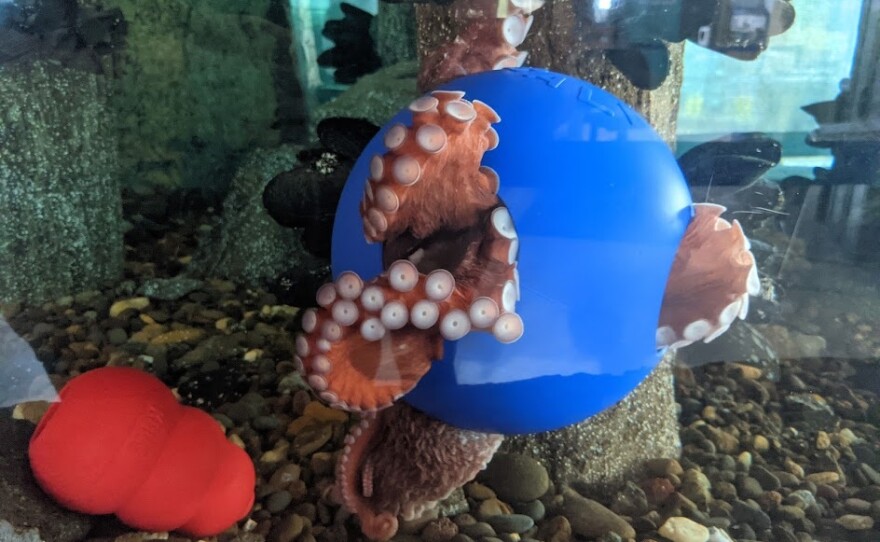
A Giant Pacific Octopus playing with toys in the tank at Hatfield Marine Science Center.
Courtesy of Jaimie Hart / Hatfield Marine Science Center
Oregon State University’s marine researchers want an octopus. They’re asking local fishermen to let them know if they happen to find one.
Oregon State University’s Hatfield Marine Science Center in Newport keeps an octopus for six to nine months before returning it to the wild.
Jaimie Hart is the Visitors Center Aquarist. She said they observe behavior and physical changes and what those changes might mean.
“For example, before an octopus might enter its reproductive stage, there’s physical signs that change (in) their eyes and their skin,” said Hart.

Hart says octopus change color depending on their mood and physical changes.
Courtesy of Jaimie Hart / Hatfield Marine Science Center
She said it’s not easy to go out in the ocean and find one giant Pacific octopus. So local fishermen are their main source for the cephalopods. She said they’re sometimes accidental stowaways.
“An octopus may see a perfectly easy meal in this crab pot,” said Hart. “So they climb in there and get pulled on fishing vessels as bycatch. So, we’re super appreciative of the local fishermen who do call us for donations, because that’s basically our sole resource for them.”
— OSU Hatfield (@HatfieldMSC) November 28, 2023
Hart said she thinks it’s more likely that someone will pull up an octopus once crabbing season gets underway. She said they’re putting together kits to hand out to fishermen to safely transport octopuses to shore.
When they receive an octopus, they go through a 30-day quarantine period. During that time they work to build trust between the octopus and the handler. Then they can start to acclimate them to being on exhibit.
Related: University of Oregon research offers a window into how octopuses see
Hart said she loves working with octopuses.
“It’s amazing. It’s my favorite part of the job,” she said. “They’re extremely intelligent creatures. Every day you learn something new. We really appreciate when we have one in our care so we can learn more and convey what we’re learning to the public. It’s the best part of the job.”

Jaimie Hart says they invite the public to watch feeding sessions with the octopus and share information and answer visitor questions.
Courtesy of Jaimie Hart / Hatfield Marine Science Center
When they have an octopus in residence, the public can watch it during feeding sessions at the Hatfield Marine Sciences visitor center.
When it’s time to return the octopus to the wild, Hart said, they are able to tag along on a research vessel from OSU and find a rocky reef offshore and release the octopus out there.
Related: The Mysterious Mind of the Octopus

